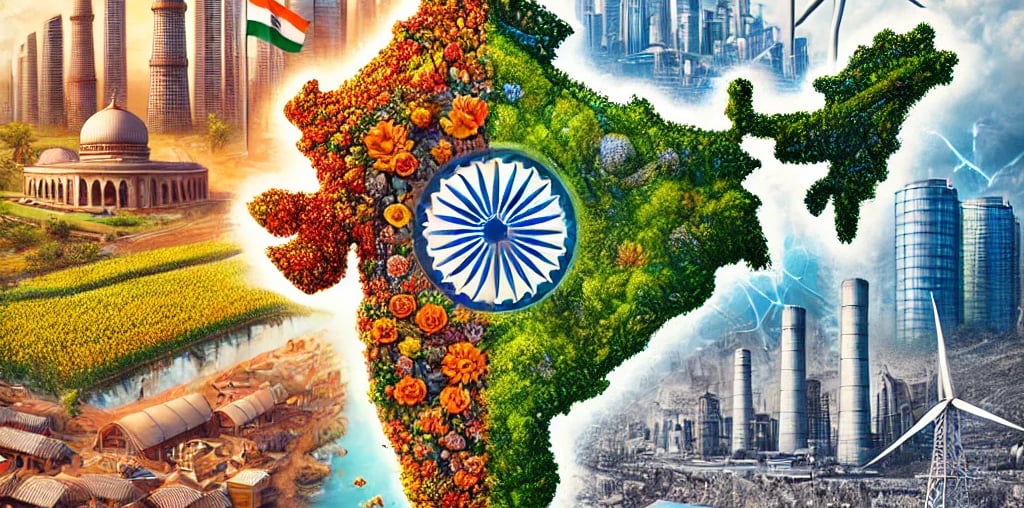India at a Crossroads: Booming Growth or Looming Challenges?
Dive into India's dual reality as we explore its meteoric rise as a global economic powerhouse alongside persistent societal and infrastructural challenges. From unicorn startups to underdeveloped systems, this analysis uncovers the puzzle of India’s future trajectory.
DIGITAL HORIZONS
Swapnil Meena
12/9/20243 min read


India: Booming or Dooming?
As 2024 comes to an end, the question remains: Is India truly booming or dooming? Many lean towards doom, but is that perception reality, or is it shaped by algorithms showing us what garners the most attention? Let’s dive deeper into the answer.
India Booming
Even though India appears like a puzzle with missing or damaged pieces, let’s explore some aspects that might surprise you.
1. Economic Growth
India has emerged as the fifth-largest economy in the world by nominal GDP. While many attribute this to the leadership of Modi ji, its roots trace back much further. The groundwork was laid during the post-independence period (1947-1991), with an average growth of about 7% until the IT boom in the 2000s propelled India forward. Initiatives like Make in India continue to drive growth today.
2. Innovative India
Many Indians overlook the innovative advancements in their own country, possibly because they haven’t experienced life abroad. Did you know India witnesses over 100 startup unicorns every year? Not every startup succeeds, but some are thriving and reshaping industries.
Practo (2008): A Bangalore-based healthcare platform offering 24/7 online doctor consultations, diagnostic services, and health record management. Practo is not only revolutionizing healthcare in India but also expanding to countries like Singapore and Indonesia. Future plans include reaching rural India, making healthcare accessible to all.
DeHaat (2012): An agritech company based in Haryana, providing farmers with quality inputs like seeds, fertilizers, and equipment. Using AI for weather forecasts and strategy optimization, DeHaat connects farmers directly with buyers, eliminating middlemen and improving incomes. With a network of 1.5 million farmers as of 2023, DeHaat plans to incorporate blockchain for transparency and expand globally.
Unified Payments Interface (UPI): India’s UPI system, managed by the NPCI, is unmatched in scale and efficiency. Unlike other countries that use multiple platforms for digital payments, UPI provides a seamless, secure, and free system accessible to millions. Its simplicity and reliability make it a global standout.
3. Infrastructure and Renewable Energy
India has undertaken significant infrastructure projects to boost connectivity and sustainability:
Bharatmala (2017): A highway and road connectivity initiative, with 17,411 km completed as of 2024 and a target of 38,000 km.
Sagarmala (2015): Focused on port modernization and reducing trade costs, with 172 projects completed and 235 under implementation.
Solar Energy: India is the third-largest producer of solar power, adding renewable energy at double the rate of coal. Visit Rajasthan’s Bhadla Solar Park, the world’s 11th-largest solar park, for a glimpse of India’s green future.
4. The Creative Workforce
India’s youth population is its strength, offering immense potential. While job creation remains a challenge, this is a call for creativity and innovation. The younger generation’s resourcefulness can pave the way for solutions and opportunities.
5. Western Influence and Social Awareness
Adopting aspects of Western culture, such as maintaining cleanliness or expressing gratitude, is fostering positive societal change in India. Additionally, growing social awareness around health, sustainability, and pollution is a step in the right direction.
Is India Dooming?
1. The Five-Year Plans
India adopted the Soviet Union’s five-year plans post-independence, focusing on heavy industrialization and collective agriculture. However, these plans failed to account for India’s diverse states and resources. Discontinued in 2015 and replaced by NITI Aayog, this misstep set India back compared to nations that chose more adaptable strategies.
2. Consumerism and Debt
A growing trend of excessive spending on luxury items like iPhones and watches, often financed through loans, risks creating financial instability for individuals, leading to broader economic consequences.
3. Legal and Educational Challenges
India’s legal system struggles with inefficiencies, outdated processes, and a massive backlog of cases, undermining justice and deterring accountability. Similarly, the education system is overly competitive, with limited opportunities and inadequate focus on skill-based training. Expanding sports and vocational education could help balance the system and unlock potential.
4. Lack of Unity
Regional, religious, and cultural divides continue to hamper national cohesion. For instance, the Northeast often feels alienated from mainstream Indian development. A unified approach is essential for progress.
5. Manufacturing Deficit
India’s manufacturing sector lags behind its thriving service sector. While Make in India is a step in the right direction, building trust in local brands and fostering indigenous industries are crucial for reducing reliance on imports and achieving sustainable growth.
Conclusion
India faces significant challenges, but its potential for growth is equally immense. The government alone cannot transform the nation; citizens must actively participate in raising awareness, fostering unity, and driving change. The question isn’t whether India is booming or dooming—it’s whether we will seize the opportunities to build a better future.
Insights
Explore technology trends and their global impact.
Connect
Learn
contact@bizgeoai.com
© 2024. All rights reserved.
